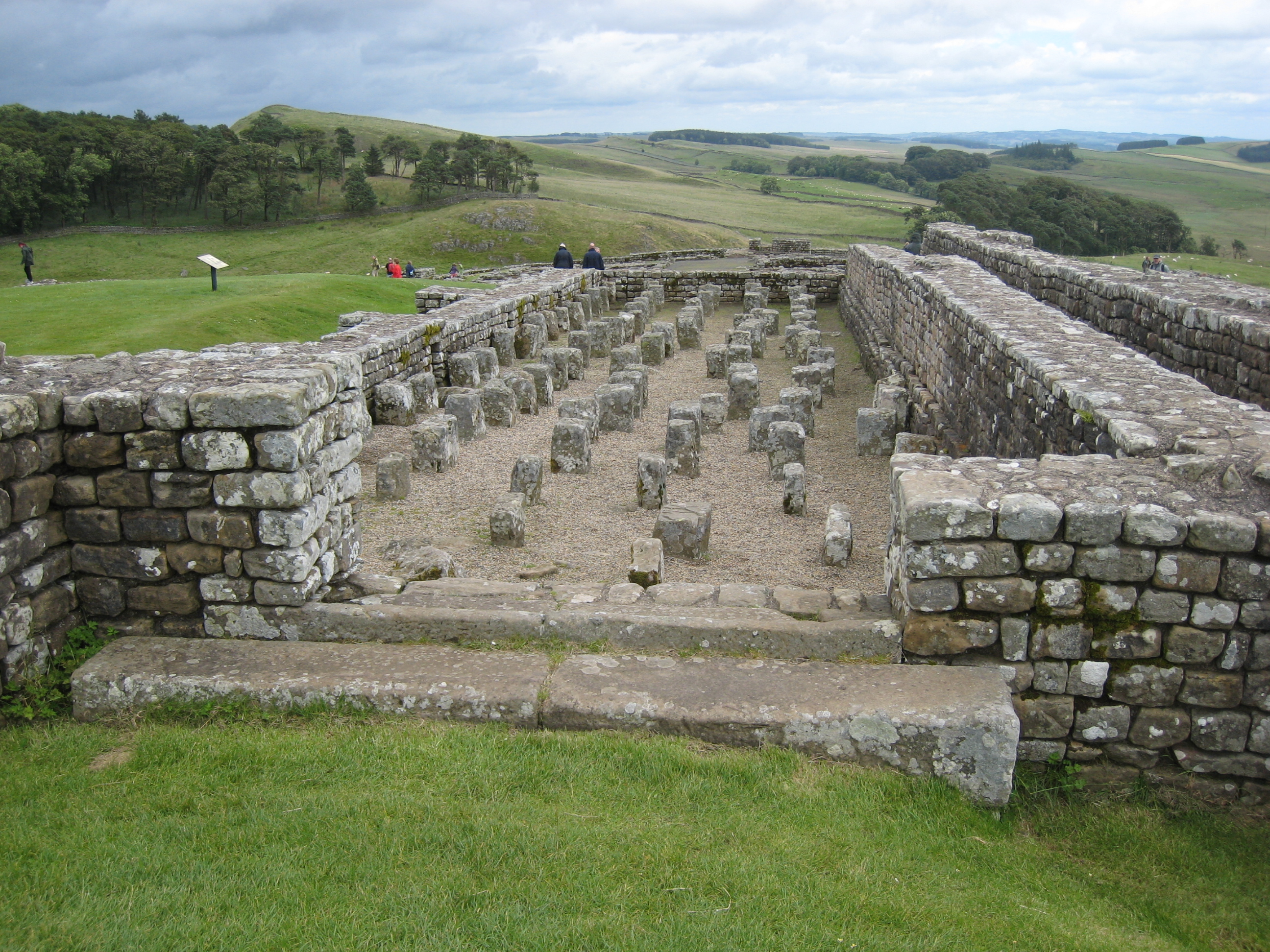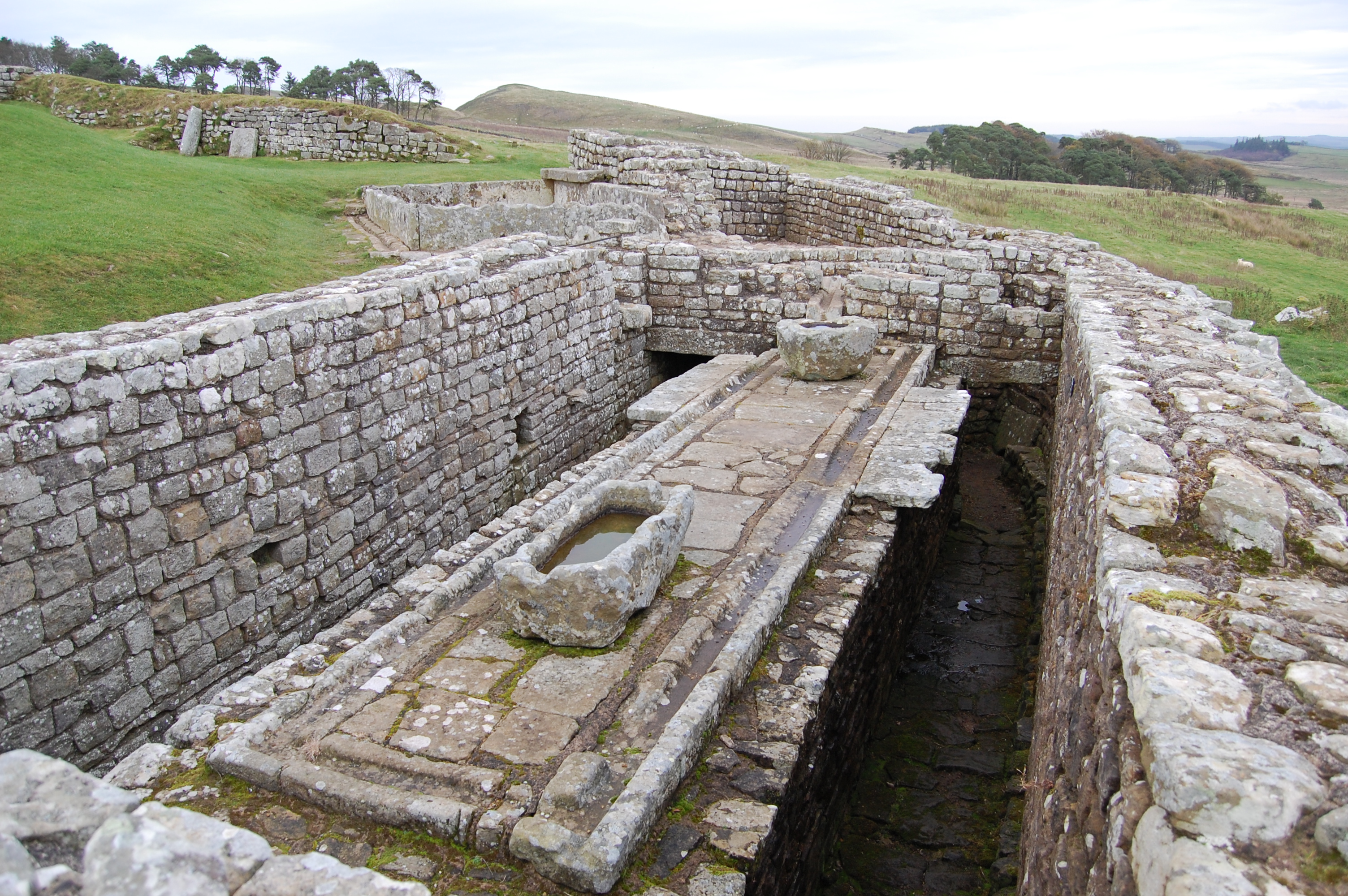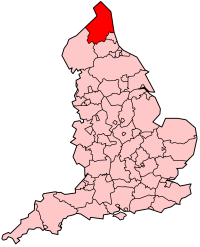|
Housesteads Roman Fort
Housesteads Roman Fort is the remains of an auxiliary fort on Hadrian's Wall, at Housesteads, Northumberland, England, south of Broomlee Lough. The fort was built in stone around AD 124, soon after the construction of the wall began in AD 122 when the area was part of the Roman province of Britannia. Its name has been variously given as Vercovicium, Borcovicus, Borcovicium, and Velurtion. The 18th-century farmhouse Housesteads gives the modern name. The site is owned by the National Trust and is in the care of English Heritage. Finds can be seen at the site, in the museum at Chesters, and in the Great North Museum: Hancock in Newcastle upon Tyne. History Hadrian's Wall was begun in AD 122. A fort was built in stone at the Housesteads Roman Fort site around AD 124 overlying the original Broad Wall foundation and Turret 36B, about two miles north east of an existing fort at Vindolanda. The fort was repaired and rebuilt several times, its northern defences being particularl ... [...More Info...] [...Related Items...] OR: [Wikipedia] [Google] [Baidu] |
Britannia
Britannia () is the national personification of Britain as a helmeted female warrior holding a trident and shield. An image first used in classical antiquity, the Latin ''Britannia'' was the name variously applied to the British Isles, Great Britain, and the Roman province of Britain during the Roman Empire. Typically depicted reclining or seated with spear and shield since appearing thus on Roman coins of the 2nd century AD, the classical national allegory was revived in the early modern period. On coins of the pound sterling issued by Charles II of England, Scotland, and Ireland, Britannia appears with her shield bearing the Union Flag. To symbolise the Royal Navy's victories, Britannia's spear became the characteristic trident in 1797, and a helmet was added to the coinage in 1825. By the 1st century BC, Britannia replaced Albion as the prevalent Latin name for the island of Great Britain. After the Roman conquest in 43 AD, ''Britannia'' also came to refer to the Roman ... [...More Info...] [...Related Items...] OR: [Wikipedia] [Google] [Baidu] |
Cuneus Frisionum
''Cuneus Frisionum'' or ''Frisiorum cuneus'' are the names of units of Frisian auxiliaries in the Roman army. Two memorial stones in Housesteads, Hexham, England mention the name. They were engraved by Frisian soldiers from Twente (Tuihanti) in the 3rd century between 222 and 235, and are dedicated to Mars Thingsus. They were discovered in 1883. One is from a pillar shaped altar and the other from a smaller altar; they are engraved in badly written Latin: :DEO MARTI ET DVABVS ALAISIAGIS ET N AVG GER CIVES TVIHANTI CVNEI FRISIORVM VER SER ALEXANDRIANI VOTVM SOLVERVNT LIBENTES M and: :DEO MARTI THINCSO DVABVS ET ALAISAGIS BEDE ET FIMMILENE ET N AVG GERM CIVES TVIHANTI VSLM They mean "To the god Mars and the two Alaisiagae, and to the divine power of the Emperor, the Germanic tribesmen of Tuihantis of the formation of Frisians of Vercovicium, Severus Alexanders's own, willingly and deservedly fulfilled their vow." and "To the god Mars Thincsus and the two Alaisiagae In Romano- ... [...More Info...] [...Related Items...] OR: [Wikipedia] [Google] [Baidu] |
John Hodgson (antiquary)
John Hodgson (1779–1845) was an English clergyman and antiquary, known as the county historian of Northumberland. Early life The son of Isaac Hodgson and Elizabeth, daughter of William Rawes, he was born at Swindale, in the parish of Shap, Westmoreland, on 4 November 1779; his father was a stonemason. Hodgson studied at the grammar school of Bampton from the age of seven to nineteen. He learned a good deal of classics, mathematics, chemistry, botany, and geology, and acquired an interest in natural history and local antiquities, through rambles in the countryside. His parents were too poor to make a university education possible, and at the age of twenty he started work as the master of the village school at Matterdale, near Ullswater. He soon moved to a school at Stainton, near Penrith. Early in 1801 he was appointed to the school of Sedgefield in County Durham, where the endowment was £20. The rector of Sedgefield, George Barrington, was a nephew of Shute Barrington, t ... [...More Info...] [...Related Items...] OR: [Wikipedia] [Google] [Baidu] |
Northumberland Record Office
Northumberland Archives holds the archives for the county of Northumberland. The archives are held at Woodhorn and Berwick-upon-Tweed and run by Northumberland County Council Northumberland County Council is a unitary authority in North East England. The population of the non-metropolitan unitary authority at the 2011 census was 316,028. History It was formed in 1889 as the council for the administrative county of N .... References County record offices in England Northumberland History of Northumberland {{library-struct-stub ... [...More Info...] [...Related Items...] OR: [Wikipedia] [Google] [Baidu] |
History Of Northumberland
Northumberland, England's northernmost county, is a land where Roman occupiers once guarded a walled frontier, Anglian invaders fought with Celtic natives, and Norman lords built castles to suppress rebellion and defend a contested border with Scotland. The present-day county is a vestige of an independent kingdom that once stretched from Edinburgh to the Humber, hence its name, meaning literally 'north of the Humber'. Reflecting its tumultuous past, Northumberland has more castles than any other county in England, and the greatest number of recognised battle sites. Once an economically important region that supplied much of the coal that powered the industrial revolution, Northumberland is now a primarily rural county with a small and gradually shrinking population. Prehistory As attested by many instances of rock art, the Northumberland region has a rich prehistory. Archeologists have studied a Mesolithic structure at Howick, which dates to 7500 BC and was identified as Br ... [...More Info...] [...Related Items...] OR: [Wikipedia] [Google] [Baidu] |
John Clayton (town Clerk)
John Clayton (10 June 1792 – 14 July 1890) was an antiquarian and town clerk of Newcastle upon Tyne, England, during the nineteenth century. He worked with the builder Richard Grainger and architect John Dobson to redevelop the centre of the city in a neoclassical style (Grainger Town), and Clayton Street in Newcastle is named after him. He did much to preserve the remains of Hadrian's Wall. Early life and career Son of Nathaniel Clayton (Town Clerk of Newcastle upon Tyne from 1785 to 1822), he was educated at Kirkoswald School in Northumberland and received classical education at Uppingham. He began work in the firm of solicitors that had been established by his father Nathaniel in the Bigg Market in Newcastle in 1778, and which became Clayton and Dunn, and qualified as an attorney in 1815. John become Under-Sheriff in 1816 before succeeding his father as Town Clerk in 1822, remaining in post until 1867. He never married, but shared the family's townhouse in Fenkle Street, ... [...More Info...] [...Related Items...] OR: [Wikipedia] [Google] [Baidu] |
William Stukeley
William Stukeley (7 November 1687 – 3 March 1765) was an English antiquarian, physician and Anglican clergyman. A significant influence on the later development of archaeology, he pioneered the scholarly investigation of the prehistoric monuments of Stonehenge and Avebury in Wiltshire. He published over twenty books on archaeology and other subjects during his lifetime. Born in Holbeach, Lincolnshire, as the son of a lawyer, Stukeley worked in his father's law business before attending Bene't College, Cambridge. In 1709 he began studying medicine at St Thomas' Hospital, Southwark, before working as a general practitioner in Boston, Lincolnshire. From 1710 till 1725 he embarked on annual tours of the countryside, seeking out archaeological monuments and other features that interested him; he wrote up and published several accounts of his travels. In 1717, he returned to London and established himself within the city's antiquarian circles. In 1718 he was elected a Fello ... [...More Info...] [...Related Items...] OR: [Wikipedia] [Google] [Baidu] |
Bastle House
Bastel, bastle, or bastille houses are a type of construction found along the Anglo-Scottish border, in the areas formerly plagued by border reivers. They are fortified farmhouses, characterised by security measures against raids. Their name is said to derive from the French word "bastille". Characteristics The characteristics of the classic bastle house are extremely thick stone walls (about 1 metre thick), with the ground floor devoted to stable space for the most valuable animals, and a vaulted stone or flat timber floor between it and the first floor with internal access such as a stairway or ladder.Brunskill, R. W.. ''Houses and cottages of Britain: origins and development of traditional buildings''. Great Britain: Victor Gollancz in association with Peter Crawley, 1997. 28-29. Print. The family's living quarters were on the floor above the ground, and during the times before the suppression of the reivers, were only reachable by a ladder which was pulled up from the i ... [...More Info...] [...Related Items...] OR: [Wikipedia] [Google] [Baidu] |
Aberdeen
Aberdeen (; sco, Aiberdeen ; gd, Obar Dheathain ; la, Aberdonia) is a city in North East Scotland, and is the third most populous city in the country. Aberdeen is one of Scotland's 32 local government council areas (as Aberdeen City), and has a population estimate of for the city of Aberdeen, and for the local council area making it the United Kingdom's 39th most populous built-up area. The city is northeast of Edinburgh and north of London, and is the northernmost major city in the United Kingdom. Aberdeen has a long, sandy coastline and features an oceanic climate, with cool summers and mild, rainy winters. During the mid-18th to mid-20th centuries, Aberdeen's buildings incorporated locally quarried grey granite, which may sparkle like silver because of its high mica content. Since the discovery of North Sea oil in 1969, Aberdeen has been known as the offshore oil capital of Europe. Based upon the discovery of prehistoric villages around the mouths of the rivers ... [...More Info...] [...Related Items...] OR: [Wikipedia] [Google] [Baidu] |
Border Reivers
Border reivers were Cattle raiding, raiders along the Anglo-Scottish border from the late 13th century to the beginning of the 17th century. They included both Scotland, Scottish and England, English people, and they raided the entire border country without regard to their victims' nationality. Their heyday was in the last hundred years of their existence, during the time of the House of Stuart in the Kingdom of Scotland and the House of Tudor in the Kingdom of England. Background Scotland and England were frequently at war during the late Middle Ages. During these wars, the livelihood of the people on the Borders was devastated by the contending armies. Even when the countries were not formally at war, tension remained high, and royal authority in either or both kingdoms was often weak, particularly in remote locations. The difficulty and uncertainties of basic human survival meant that communities and/or people kindred to each other would seek security through group streng ... [...More Info...] [...Related Items...] OR: [Wikipedia] [Google] [Baidu] |
Roman Britain
Roman Britain was the period in classical antiquity when large parts of the island of Great Britain were under occupation by the Roman Empire. The occupation lasted from AD 43 to AD 410. During that time, the territory conquered was raised to the status of a Roman province. Julius Caesar invaded Britain in 55 and 54 BC as part of his Gallic Wars. According to Caesar, the Britons had been overrun or culturally assimilated by other Celtic tribes during the British Iron Age and had been aiding Caesar's enemies. He received tribute, installed the friendly king Mandubracius over the Trinovantes, and returned to Gaul. Planned invasions under Augustus were called off in 34, 27, and 25 BC. In 40 AD, Caligula assembled 200,000 men at the Channel on the continent, only to have them gather seashells ('' musculi'') according to Suetonius, perhaps as a symbolic gesture to proclaim Caligula's victory over the sea. Three years later, Claudius directed four legi ... [...More Info...] [...Related Items...] OR: [Wikipedia] [Google] [Baidu] |
Latrine
A latrine is a toilet or an even simpler facility that is used as a toilet within a sanitation system. For example, it can be a communal trench in the earth in a camp to be used as emergency sanitation, a hole in the ground (pit latrine), or more advanced designs, including pour-flush systems. The term "latrine" is still commonly used military parlance, less so in civilian usage except in emergency sanitation situations. Nowadays, the word "toilet" is more commonly used than "latrine", except for simple systems like "pit latrine" or "trench latrine". The use of latrines was a major advancement in sanitation over more basic practices such as open defecation, and helped control the spread of many waterborne diseases. However, unsafe defecation in unimproved latrines still remained a widespread problem by the end of 2020, with more than 3 billion people affected (46 % of the global population). Eradication of this public health threat is one of the United Nations' 17 goals for s ... [...More Info...] [...Related Items...] OR: [Wikipedia] [Google] [Baidu] |





%2C_Oxfordshire_-_geograph.org.uk_-_605684.jpg)



